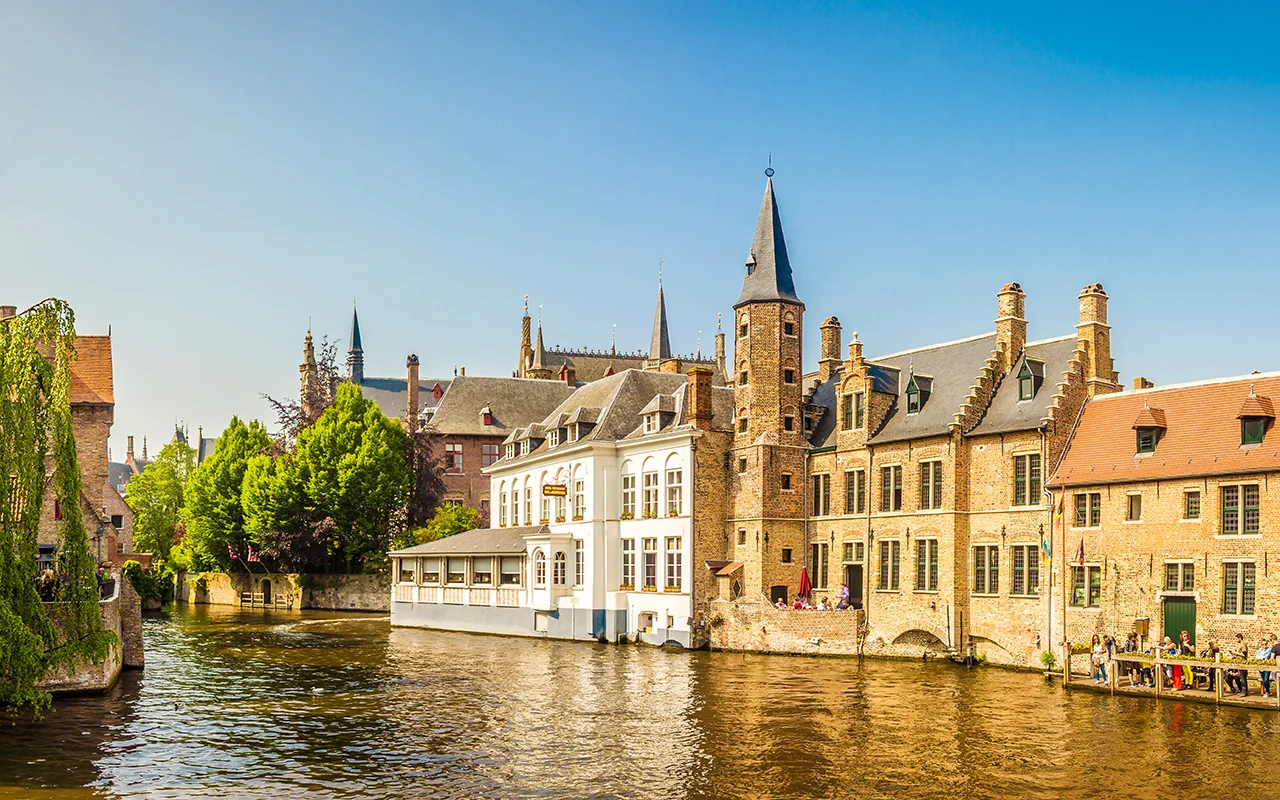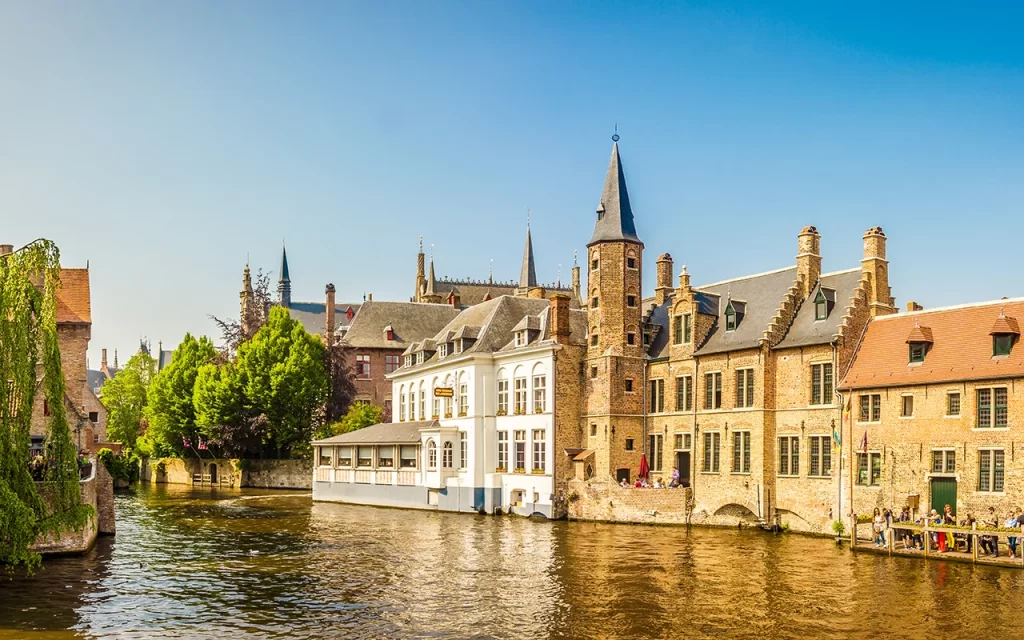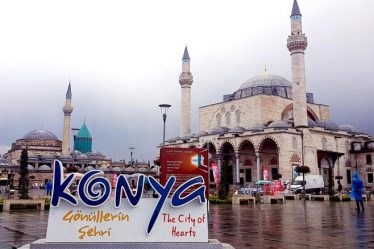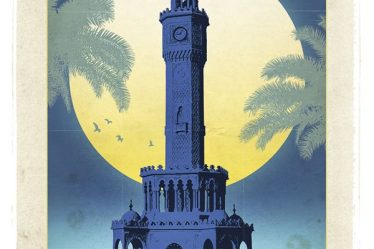
Bruges is the capital and pride of Belgium ‘s West Flanders region. A true medieval city with its exquisite architecture and winding canals winding through 12th-century mansions. The streets and canals of the city make you feel like you are in a magical fairy tale. It is an elegant city that takes its visitors back to the past with its beautiful streets and squares that host magnificent buildings.
Known as the Venice of the North, Bruges is considered one of the most charming cities in Europe, with its most photogenic water canals and fairytale architecture. With its chocolate and beer, lace and flower markets, the city is one of the important medieval cities in Europe that has survived to the present day, a truly magical world.

Bruges is one of the best preserved cities in Europe. An extraordinary mix of medieval architecture, stone streets, magnificent squares, and wide and peaceful interlocking canals. It’s like a place that stopped the clock in the Middle Ages. Its winding streets, intertwining water channels and Gothic architecture make you wish you would never leave here.
Despite its tiny size, it has been offering more than it seems for centuries. It has a fascinating atmosphere with its museums with rich collections, living breweries, world-famous boutique chocolate shops, and narrow stone streets. This city, which has achieved great success in economic and cultural terms, is today one of the most popular destinations in Europe.
CONTENTS GUIDE ▽ hide
Bruges Travel Guide
Places to Visit in Bruges 📌
- Market Square: Market
- Belfry Bell Tower
- Groeningemuseum
- Historium Museum
- Town Hall
- Church of Our Lady
- Basilica of the Holy Blood
- St John’s Hospital
- Canals and Gates of Bruges
- Chocolate Museum: Choco-Story
- Lace Center: Kantcentrum
- De Halve Maan Brewery
- Beguinage
- Minnewater
- Windmills
Bruges is a city in Belgium, officially known as the Kingdom of Belgium. The city, which is the capital of the Belgian West Flanders province, is a tourist center famous for its medieval architecture, chocolate varieties, traditional lace, canals and Belgian beer. Bruges is a Gothic jewel city that has seen both good and bad times but has survived to tell its full story.
The city was born as a Gallo-Roman settlement on the banks of the Dijver and Reie rivers. The first mention of its name started in 864 with the word ‘Bruggia’ meaning port or landing area. Until the 11th century, ships could travel from the Reie River to the heart of the city. At that time, with the development of the clothing industry, the city became the hub of international trade.
Although the years 1200-1400 were very prosperous in commercial terms, a major collapse began when the sea routes were filled with sand and mud. This disaster of that period has become a favorable situation today, adding a completely different atmosphere to the city. The opened Het Zwin canal extends to Damme in the north of the city. Thanks to this canal, the city became a commercial center again.
It is now a living museum, a symbol of the modern Flemish renaissance, and it is wonderful that it has remained untouched for centuries. Today, Bruges is known as the ‘Venice of the North’ due to its city structure surrounded by canals.
Malta
French and Dutch, one of the official languages of Belgium, are spoken in Bruges. English is also widely known in the city. Belgian currency is Euro. Bruges is 1 hour behind Turkey. The population of the city is 140 thousand.
WHERE IS BRUGGE
📍 Bruges is the city of Belgium, located on the European continent. Belgium is also a Western European country. Bruges, also known as Bruges or Brügge, is the capital of Belgium’s West Flanders Region. Located in the northwest of Belgium, on the North Sea coast, the city also has a small commercial port.
WHAT IS REQUIRED TO GO TO BRUGES
ⓘ To go to Bruges, you need to have a Green Passport or a Schengen visa . If you have not had any visa experience yet, my blog posts How to Get a Visa and How Much Are the Visa Fees will guide you. If you do not have a passport, read my articles on Passport Types and How to Apply for a Passport . When going abroad, you have to pay an international exit fee .
HOW TO GET TO BRUGES
✈️ The closest airport to Bruges is located in Brussels, approximately 110 km east of Bruges. You can fly to Brussels with direct flights from Istanbul Airport with Turkish Airlines, or from Sabiha Gökçen Airport with Pegasus Airlines, every day of the week, with direct flights lasting 3 hours and 25 minutes.
Ostend-Bruge International Airport, located in Ostend, approximately 25 km away from Bruges, is an airport with flights from some cities of southern European countries. During the season, you can search for tickets from places such as Antalya, Bodrum and Izmir. Another airport close to Brussels is Brussels South Charleroi Airport, which is approximately half an hour away from Brussels.
It takes approximately 1.5 hours from Brussels to Bruges. You can get to Brussels Midi Train Station from Brussels Airport in 25 minutes. You can also go to Bruges by train from Midi in about 1 hour. Unfortunately, Bruges train station is not in the city centre. 1.5 km from the train station.
The main bus terminal is located just outside the train station. Among the options you can buy are a one-way ticket valid within 1 hour, an SMS ticket that is cheaper and can be purchased by phone, a Lijn card with 10 tickets, and a ticket valid for 1-3 or 5 days.
There are train services from Bruges to the capital Brussels (1 hour) and Ghent (20 minutes) every half hour. Trains run hourly to Antwerp (70 minutes), De Panne (1 hour), Knokke (15 minutes), Kortrijk (40 minutes), Ostend (15 minutes) and Zeebrugge (10 minutes). If you want to go to Ypres (2 hours), you can take the train to Kortrijk and take the Ypres train that leaves every hour.
BRUGES NEREDE KALINIR
Hotel Le Bois De Bruges (★★★★), a clean and comfortable hotel 7-8 minutes’ walk from the medieval center of the city. Grand Hotel Casselbergh Bruges (★★★★), has a great location in the center of the city. Hotel Ter Brughe by CW Hotel Collection is a pleasant hotel located in a historical building by the canal, an 8-minute walk from the Market Square and the Bruges Bell Tower. Save
ibis Budget Brugge Centrum Station as an affordable option close to the train station. You can consider Snuffel Youth Hostel and Hostel Lybeer Bruges and St Christopher’s Inn Hostel at The Bauhaus as hostel options where you will spend less money on accommodation.
Places to Visit in Bruges 📌
➡My Instagram account is @yoldaolmak ✔️
The stone streets of Bruges are constantly walked by millions of people, and the best way to fully enjoy this magical city is definitely to walk. Founded long before the advent of motor vehicles, the city was never designed for cars anyway.
Malta
If you want to get from point A to point B, listen to the locals and rent a bike. Cycling in Bruges is a complete pleasure because it is a flat city. A bicycle tour within the city is very fun and easy.
I have listed the places to visit in Bruges so that you can easily do it on foot. The entire route is approximately 3.5 km. It takes 45 minutes to see these spots just by walking without stopping. The one that lengthens the route is Kantcentrum Lace Center, if you remove it from the list, the route decreases to 2.3 km. You can see the most important points in just half an hour, but of course you need to make time for each one.
You can’t go to Bruges and not take a boat tour. The canals reflect the historical city center from a very different perspective. If you buy an evening tour, you can witness Bruges at its most romantic (and cheapest). Boat tours, which you can find almost everywhere, last approximately 30 minutes.
The horse-drawn carriage tour, which is among the things to do in Bruges, departs from Markt Square and takes 30 minutes at most. You can also join the 2-hour guided walking tours organized by the tourism office. The tour, which starts at 16:00 in front of the tourist office, not only allows you to better understand the history of the city, but also usually ends in one of the most beautiful bars in the city.
- Market Square: Market
Bruges, Belgium
The Market Square, known as the Markt , is the heart of Burgge. Bruges’ breathtaking historic city center, which is a UNESCO World Heritage Site, is a true medieval masterpiece. In this open-air museum, visitors can see the most magnificent examples of architecture, art, history and, of course, food. The most beautiful places to visit in Bruges are located in and around this square.
Although the medieval Gothic architecture is the main attraction here, there are also Romanesque buildings, baroque, rococo touches from the Renaissance period, neo-gothic works and a small amount of New Art and Art Deco examples. But the most prominent works of Bruges are the Gothic ones. They seem endless in number and make the whole city feel like you’re in an animation.
In few places in Europe are squares as adorned with magnificent cafes, shops and architectural works of art as in Bruges. Although most of the current buildings in the Markt of Bruges, which has been both the main shopping and business center of the city since 958, belong to the 19th century, the 13th-century structure, the Belfry Bell Tower, still continues to serve its former function.
- Belfry Bell Tower
Belfry Bruges
Belfry Bell Tower
The medieval Belfry Bell Tower (Belfry of Bruges) dates back to 1240, when Bruges was one of the largest centers in the fabric industry. The tower, which was severely damaged in a fire but was rebuilt 40 years later, has managed to survive until today despite constant fires over the centuries. When you reach the top of the 366 steps, a magnificent view will be waiting for you.
The 83-meter tall tower, which is among the top places to visit in Bruges, meets all the expectations of its visitors with a breathtakingly beautiful panoramic view of the city. The incredible clock mechanism that you can see as you go up and the 47 bells designed to manage the life in the city by playing different melodies and to warn when the enemy comes are among the must-visit places.
⏰ Belfry Bell Tower visiting hours are 09.30-18.00, 7 days a week. Closed on 25 December, 1 January and 12 March 💶 Belfry Bell Tower entrance fee is 12€, 10€ for students, free for visitors under 5 years old.
- Groeningemuseum
Groeningemuseum is a museum whose collections include the works of Jan van Eyck made in Bruges in his late periods. It also includes works by Belgian modern artists such as Hieronymus Bosch, Hugo Van Der Goes, Marcel Broodthaers and Hans Memling, especially Paul Delvaux’s work ‘Serenity’.
Although it is a little small in size, Groeningemuseum manages to make up for this gap with its content. ⏰ Groeningemuseum visiting hours are 09.30-17.00 every day except Mondays. The museum is closed to visitors on January 1 and December 25. 💶 Groeningemuseum entrance fee is 8€, students 6€, free for under 12s.
- Historium Museum
Bruges
Historium and Belfry of Bruges
Imagine creating your own time machine. Historium Museum (Historium Bruges) is the place where you can experience and feel the golden age of Bruges in the best way, thanks to its multi-media feature. As you move from one of the many thematic rooms to another, you can see, hear and smell what life was like in the 15th century.
Add the museum to your list of places to visit in the city to witness the period when Bruges was one of the most important cities in Europe. ⏰ Historium Museum visiting hours are 10.00-18.00, 7 days a week. 💶 Historium Museum entrance fee is 17.50€, students are charged 13.50€ and visitors aged 6-12 are charged 11€.
- Town Hall
Bruges City Hall
Bruges City Hall
The history of Bruges City Hall (Rathaus – Bruges City Hall) dates back to 1376. The Hanseatic League, a commercial and political union in the 15th century, was headquartered in the town of Bruges. The town hall and many other magnificent buildings were all built during that period. The Gothic council chamber is located on the first floor of the building and is open to all visitors.
Its doors are decorated with magnificent medieval carvings, and there is also a separate room where documents and works of art are exhibited. City Hall visiting hours are open 7 days a week between 09.30-17.00. Entrance fee is 6€, students are 5€, children under 17 are free.
Malta
- Church of Our Lady
Bruges Church of Our Lady
Church of Our Lady Bruges
After the Belfry Tower, the 122-meter-high Virgin Mary Church (Onze-Lieve-Vrouwekerk) is one of the most impressive and beautiful buildings in Bruges. Inside this legendary church, you can see Michelangelo’s famous Madonna and Child painting and the sarcophagi of Mary of Burgundy and Charles the Brave.
Onze Lieve Vrouwekerk, the tallest and most visually striking building in Bruges, is a truly medieval structure. The most well-known feature of the Virgin Mary Church, Onze Lieve Vrouwkerk, which overlooks the city with its pointed top, is the ‘Madonna and Child’ statue made of white marble.
This statue is the only work made by the famous artist Michelangelo when he left Italy. In addition to this magnificent statue on an altar in the southern part of the chapel, there is also the eternal resting place of Charles the Brave and Mary of Burgundy in the half-dome section of the church.
⏰ Visiting hours of Virgin Mary Church are 09.30-17.00 6 days a week except Sundays, and 13.30-17.00 on Sundays 💶 Virgin Mary Church entrance fee is 6€, 5€ for students, no fee is charged for visitors under the age of 17.
- Basilica of the Holy Blood
Places to visit in Bruges
Basilica of the Holy Blood, Bruges
The Basilica of the Holy Blood (Basiliek van het Heilig Bloed) is a 12th-century structure located in Burg Square. Its most important feature is that the blood stained on a piece of fabric is believed to be the blood of Jesus. Rumor has it that this sacred item was captured during the second crusade in Jerusalem.
The piece, housed in a small crystal bottle, is opened to visitors every Friday. ⏰ Holy Blood Basilica visiting hours are 09.30-12.00, 14.00-17.00, 7 days a week. 💶 Entrance to the Basilica of the Holy Blood is free. There is also an exhibition belonging to the church in the basilica, but entrance to it is 2€.
- St John’s Hospital
St John’s Hospital Museum (Sint-Janshospitaal Museum) is the oldest hospital in Europe, dating back to the 13th century. This healing house, which has helped patients for 800 years, has now been turned into a museum and its past is honored.
Diagrams showing the medical instruments and treatment techniques of the period, displayed under a magnificent wooden ceiling, will make you thankful that we live in the 21st century. Visiting hours are between 09.00-17.30, 6 days a week except Mondays. Entrance fee is 12€, students 10€, under 17 free.
- Canals and Gates of Bruges
Used Ezelpoort
Used Ezelpoort
Canals of Bruges
St John’s Hospital
Bruges Canals brought wealth and prosperity, making the town a very important trade center in the Middle Ages. The administration turned the Reie River into canals passing through the city, thus enabling merchants to bring their products to the market much more easily. When you join the boat tour on the water canals, you will understand why Bruges is called the Venice of the North.
The most beautiful and romantic of the canals is undoubtedly the Groenerei (Green Canal). The canal, which also has a wonderful view from the Peerdebrug Bridge, winds its way through lush trees and 17th-century mansions, flowing slowly and peacefully in the shadow of the cathedral tower above.
Bruges, which was heavily protected in the Middle Ages, was surrounded by walls, moats and defense towers. A large part of the walls were destroyed in the 19th century and only the moat and 4 giant gates built with great strength remained. Kruispoort, which looks like a castle in itself, is the most magnificent of these gates. The others are the majestic Smedenpoort, Ezelpoort with many swans around it, Kruispoort and Gentpoort.
- Chocolate Museum: Choco-Story
Chocolate is a word synonymous with Bruges. Be sure to learn every detail about chocolate at the Choco-Story Museum . Of course, tasting is also done in the museum, where it is explained in detail how the cocoa plant turns into such a delicious taste. It is a place where you can see how chocolate, one of Belgium’s most famous traditions, began to be obtained from cocoa in the Mayan and Aztec periods and how it came to modern times.
In this show that chocolate fans should not miss, chocolate making and tasting can be said to be an element that makes the entire visit very delicious. ⏰ Choco-Story Museum visiting hours are 10.00-17.00 between 1 January – 30 June, 10.00-18.00 between 1 July – 31 December 💶 Choco-Story Museum entrance fee is 14.50 €, students 11.50 €, 0-6 years old free of charge .
- Lace Center : Kantcentrum
lace center Bruges
bruggekantcentrum
Kantcentrum , which was a retirement home for the elderly in the 15th century, was later restored and turned into a museum for lace, Bruges’ most well-known industrial feature. Lace embroidery demonstrations are held at the center from Monday to Saturday, and if you want to learn, you can take advantage of courses.
When you leave here, there is the Jerusalem Church (Jeruzalemkerk) right next to it, and you can enter there for free with the ticket you enter here. ⏰ Kantcentrum visiting hours are 09.30-17.30, 6 days a week except Sundays. Closed to visitors on January 1st and December 25th 💶 Kantcentrum entrance fee is 6€, students are 5€, children under 6 are free.
- De Halve Maan Brewery
At the end of the 45-minute tour of the De Halve Maan Museum, visitors learn what techniques the world’s best beer-making country uses. Half Maan, the oldest among the country’s 180 breweries, continues to carry on this family tradition for 6 generations, from 1856 to the present day. A beer of your choice is included in the museum visit, which has a small entrance fee.
It is famous all over the world for its Belgian beer and breweries. This family-run brewery, which has been producing beer continuously since 1856, offers many types of beer. It is also the only remaining brewery in the historic city center and offers daily tours in many different languages, and you have the chance to taste the beers at the end of each tour. Just climbing to the top of the brewery and seeing the view is worth the money you pay for this ticket.
⏰ De Halve Maan Museum visiting hours are 11.00-16.00 every day except Saturday, and 11.00-17.00 on Saturdays. 💶 De Halve Maan Museum entrance fee is 12€, 11€ for online purchases. Visitors aged 6-12 can enter for €6.
- Beguinage
Beguinage, Bruges
Baroque style Beguinage buildings
In ancient times, there were nurses’ homes affiliated with the Catholic church called Beguine , and they still exist in the Netherlands and Belgium. Unlike nuns, women who have never been married or are widowed dedicate themselves to the church without adhering to a vow. Begijnhof, one of the houses where these nurses lived, is one of the most popular places in Bruges.
Beguines first appeared in 1245. By the 17th century, their number increased to 3 hundred. Established as a self-sufficient commune, the Beguines also served as a nursing home, farm, beer brewery and sometimes a church. He says that the carved grapes you will see at the entrance symbolize the vineyards they owned in the past and the grapes used to make vinegar.
Today, Beguines is run by Benedict nuns. Nurses still wear clothes like old times and continue to follow some of the customs and traditions of their ancestors. Begijnhof visiting hours are 06.30-18.30, 7 days a week. Entrance fee is 2€, 8-12 years old is 1€.
- Minnewater
Bruges, Belgium
Minnewater, Bruges
Minnewater (Lake of Love) may be the most beautiful place in Bruges, famous for its canals, where you can see the peace of the city reflected in the water. The name of the city, which has a wide canal also known as the Lake of Love, comes from the death of a girl named Minna while escaping from an arranged marriage. According to local belief, couples who cross this bridge together will be happy for a lifetime. - Windmills
Of the 25 windmills that once stood on the outskirts of Bruges, only four remain today. The windmills, which can be found in the park between Kruispoort and Dampoort on the east side, are open to visitors throughout the summer. Koeleweimolen was built in 1765 and moved from Dampoort to its current location in 1996. Sint-Janshuismolen has remained where it was first built since 1770.
⏰ Both of them are located on Kruisvest and can be visited on Sundays between 09.30-12.30, 13.30-17.00 💶 3€ for adults, 2€ for the elderly and those between the ages of 6-25, and free for children under 5.
WHAT TO BUY IN BRUGES
There are many good options and top brands in the city, but the prices are quite high due to tourists. As can be expected, numerous chocolate shops are scattered throughout the historical city center. Let me tell you that the city is famous for chocolate, souvenirs, wooden decorative products, toys, stationery and lace.
The main shopping area stretches between ‘t Zand and Markt square. Steenstraat, Geld Montstraat and Jakobstraat streets are the main shopping arteries of the city. Head to the magnificent Quartier Bricole on Langestraat 50 street. There are different ornaments and trinkets here.
Bruges is considered the chocolate capital of the world. If you even take a look at the seductive chocolate shop windows, you suddenly find yourself inside. While your chocolate is weighed and packaged, you may feel a little sorry about the cost. Visit markets for more affordable prices. The chocolates here are at least as good as those in the shops and are more reasonably priced.
Another famous feature of Bruges is its lace. There are more than eighty lace shops in the city. A magnificent food and drink market is held in Markt Square on Wednesday mornings. On Saturdays, clothes are sold in ‘t Zand Square. For those who are curious, the flea market that opens on the Dijver Canal every weekend attracts both locals and tourists.
WHAT TO EAT IN BRUGEGE
Bruges offers the most amazing traditional flavors of Europe. Bruges Nouvelle Cuisine, which has three Michelin stars, offers exclusive gourmet dishes such as steak stew and beer, and steamed mussels. Crispy golden potatoes are available almost everywhere, but buy them from the cars parked in Market Square.
For an authentic taste, head to De Half Maan, the only still-operating brewery in Bruges Old Town. Taste Belgium’s countless delicious beers. If you want to taste more beer, t’ Brugs Beertje is your place where you can find the best beers in Belgium. You can find 300 different beers from different regions of Belgium in the venue located on Kemel Straat 5 street.
Another interesting place is Cafe Vlissingen. This cafe on Blekestraat 2 street is the oldest cafe in Bruges. Built in 1515, the building has a very impressive character and also serves very tasty local beers. De Garre is located right next to the Market Square and is famous for its very strong beers. They have a limit of 3 beers per person.
The magical atmosphere never ends in Bruges , which is a very ambitious city for the competition of Europe’s smallest, most romantic city . Stone houses, winding canals, magnificent squares, narrow cobblestone streets… But the most impressive thing is the local people, who are always smiling and friendly to the hundreds of thousands of tourists who constantly fill this Belgian city.


